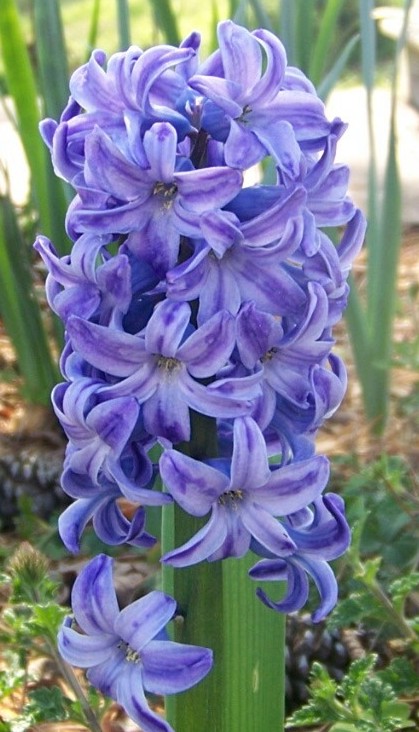|
Gardens Ablaze |
||
|
|
Hyacinth |
|
|
Detailed Bulb Profiles Site Map
Home |
Alternatively, Hyacinths are one of the bulbs that will do well when grown in a glass container with nothing but water. Any glass container will do that has a mouth that is small enough to hold the bulb just over the water level, or you can buy containers made especially for this purpose. Fill the container with water just to the point that it is barely touching the bottom of the bulb (the bulb sits pointy side up in the container). Place the container in a dark place in the refrigerator or in an unheated garage where the temperature does not rise about 50 degrees, and leave it there for 10-13 weeks, depending on your particular hyacinth bulb. Check every week or so and keep the water level just below the bottom of the bulb. Roots will emerge and begin to fill the glass during this period, and finally you will notice a white shoot emerging from the top of the bulb. Move the container to a filtered sunlight area in the house, and leave it there until that small shoot begins to turn green. Then the container can be placed in bright sunlight, and the bloom will appear within a few weeks. Unfortunately, once you have forced a Hyacinth this way, the bulb is spent and should be disposed of after flowering. It will not do well if transplanted into the garden. Outdoors, Hyacinths are easy to grow and make excellent companions for other cool weather flowering plants such as Tulips, Daffodils, or Pansies. They can be grown in full sun or part shade, and they generally bloom in mid-spring. Plant the bulbs 6-8 inches deep and 6 inches apart. Hyacinths are formal-looking plants that look good in formal rows or in large drifts. They make an excellent addition to the front of a garden, or lining paths or walkways. They appreciate a side-dressing of bulb booster after they have bloomed, and generally need to be replanted every two years or so as, like tulips, the bulbs lose their prolific flowering habit after a couple of years. Otherwise, Hyacinths are fragrant, colorful plants that deserve a special place in the garden, and require only the most basic care.
|
|
|
Gardens Ablaze |
||
 If
you have never grown Hyacinths indoors, you are missing a truly rewarding
experience. They are easy to grow and reliably produce masses of brightly
colored flowers, but the best part is the fragrance. They will fill
your house with a delicate floral fragrance that you cannot duplicate by
any other means. For a constant supply over the winter, buy the bulbs
as soon as you can get them in the fall. Plant 10 bulbs or so to one
8 inch shallow pot or pan with the tips just showing above the soil surface.
Put the pans in a sheltered, dark place outside or in an unheated garage,
and keep the soil moist for 8 to 10 weeks. Then start bringing the
pans in at two week intervals for a show that will take you all the way
through the winter, assuming you originally prepared enough pans.
I guarantee that you will love this plant indoors!
If
you have never grown Hyacinths indoors, you are missing a truly rewarding
experience. They are easy to grow and reliably produce masses of brightly
colored flowers, but the best part is the fragrance. They will fill
your house with a delicate floral fragrance that you cannot duplicate by
any other means. For a constant supply over the winter, buy the bulbs
as soon as you can get them in the fall. Plant 10 bulbs or so to one
8 inch shallow pot or pan with the tips just showing above the soil surface.
Put the pans in a sheltered, dark place outside or in an unheated garage,
and keep the soil moist for 8 to 10 weeks. Then start bringing the
pans in at two week intervals for a show that will take you all the way
through the winter, assuming you originally prepared enough pans.
I guarantee that you will love this plant indoors! Lastly,
if you have a favorite Hyacinth type and wish to propagate it, you can follow
the steps below (but beware, this takes time and patience). Take the
bulb, and scoop out the bottom portion where the roots come out. This
is called the basil plate. Store the scooped out bulb in a container
with damp sphagnum moss, sawdust, or a similar material, and keep in a warm
area. In time, bulblets will start forming around the area where you
scooped out the basil plate. Once these bulblets are big enough, pull
them from the parent plant and place in soil. It takes up to five
years for one of these bulblets to reach flowering size, so patience is
important here. One bulb can produce up to 60 bulblets, however, so
once the wait is over, you'll have plenty of Hyacinths!
Lastly,
if you have a favorite Hyacinth type and wish to propagate it, you can follow
the steps below (but beware, this takes time and patience). Take the
bulb, and scoop out the bottom portion where the roots come out. This
is called the basil plate. Store the scooped out bulb in a container
with damp sphagnum moss, sawdust, or a similar material, and keep in a warm
area. In time, bulblets will start forming around the area where you
scooped out the basil plate. Once these bulblets are big enough, pull
them from the parent plant and place in soil. It takes up to five
years for one of these bulblets to reach flowering size, so patience is
important here. One bulb can produce up to 60 bulblets, however, so
once the wait is over, you'll have plenty of Hyacinths!